Virtual Reality (VR) Technology and Professional Development
One of the main advantages of VR technology is that it allows for a more interactive and engaging learning experience. By providing users with an immersive environment where they can practice and apply what they have learned, VR training has been shown to improve knowledge retention rates.
For example, a study conducted by Stanford University found that learners who completed a VR-based training program were able to retain 90% of the information presented, compared to only 10% for traditional classroom-based training methods. Additionally, VR training has been shown to improve retention rates even after several months, making it an effective tool for ongoing professional development.

Improving Knowledge Retention in Virtual Reality Training
Another advantage of VR technology is its ability to enhance skills development. By providing users with a realistic simulation of real-world scenarios, VR training allows learners to practice and apply their skills in a safe and controlled environment.
For example, a study conducted by the University of Maryland found that medical students who completed a VR-based surgical training program were able to perform surgeries with a higher degree of accuracy and precision than those who received traditional classroom-based training. Similarly, pilots who completed a VR-based flight simulation training program were able to complete tasks with a higher degree of proficiency than those who received traditional ground-based training.
Fostering Creativity in Virtual Reality Training
Finally, VR technology can foster creativity by providing users with an immersive environment that encourages exploration and experimentation. By allowing learners to interact with a simulated environment and create their own experiences, VR training provides an opportunity for users to think outside the box and come up with new and innovative solutions to problems.
For example, architects who completed a VR-based design training program were able to come up with more creative and innovative designs than those who received traditional classroom-based training. Similarly, designers who completed a VR-based product development training program were able to create more unique and differentiated products than those who received traditional ground-based training.
Case Studies in Virtual Reality Enhanced Professional Development
One example of VR enhanced professional development is the use of VR for surgical training. The University of California, San Francisco (UCSF) launched a VR surgical training program that provides medical students with an immersive experience where they can practice and apply their surgical skills in a simulated environment. The program has been shown to improve surgical skills and reduce the risk of errors during actual surgeries.
Another example is the use of VR for flight simulation training. The Royal Canadian Air Force (RCAF) launched a VR-based flight simulation training program that provides pilots with an immersive experience where they can practice and apply their flying skills in a simulated environment. The program has been shown to improve pilot proficiency and reduce the risk of accidents during actual flights.
FAQs on Virtual Reality Enhanced Professional Development
Is VR training more expensive than traditional classroom-based training?
While VR technology can be expensive, it is also more cost-effective in the long run as it reduces the need for physical infrastructure and equipment. Additionally, VR training provides a more immersive and engaging learning experience, leading to improved knowledge retention and skill development.
Can VR training replace traditional classroom-based training?
While VR technology cannot completely replace traditional classroom-based training, it can complement it by providing an immersive and engaging learning experience that improves knowledge retention, skill development, and creativity.
What industries are best suited for VR enhanced professional development?
Any industry that requires hands-on training or practice in a simulated environment, such as healthcare, aviation, manufacturing, and construction, can benefit from VR enhanced professional development.
Are there any potential risks associated with VR enhanced professional development?
While VR technology is generally safe, there are some potential risks associated with prolonged use, such as motion sickness and eye strain. Additionally, users may become too reliant on the virtual environment, leading to a lack of real-world experience. It is important for users to follow proper safety guidelines and to balance virtual training with real-world experience.
How can organizations incorporate VR enhanced professional development into their existing professional development programs?
Organizations can incorporate VR enhanced professional development into their existing professional development programs by partnering with VR technology providers, providing dedicated VR training facilities, and incorporating VR training into existing course offerings.
Summary
In conclusion, virtual reality technology has the potential to enhance professional development programs for mixed reality development by improving knowledge retention, enhancing skills development, and fostering creativity. By providing users with an immersive and engaging learning experience, VR technology can complement traditional classroom-based training and provide a more cost-effective and effective approach to professional development. As such, organizations should consider incorporating VR enhanced professional development into their existing programs to improve the effectiveness of their training initiatives.


